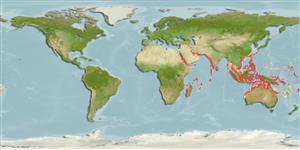>
Acanthuriformes (Surgeonfishes) >
Siganidae (Rabbitfishes)
Etymology: Siganus: Latin, siganus = a fish, rabbit fish; by the similarity of the nose (Ref. 45335).
More on author: Forsskål.
Environment: milieu / climate zone / depth range / distribution range
Ecologie
marien rifbewoner; diepte 1 - ? m (Ref. 9710), usually 5 - 30 m (Ref. 27115). Tropical; 24°C - 28°C (Ref. 27115); 30°N - 35°S
Indian Ocean: Red Sea and East Africa to the Andaman Sea.
Grootte / Gewicht / Leeftijd
Maturity: Lm ? range ? - ? cm
Max length : 40.0 cm TL mannelijk / geslacht onbekend; (Ref. 4407); common length : 35.0 cm TL mannelijk / geslacht onbekend; (Ref. 9813)
Dorsale stekels (totaal) : 13; Dorsale zachte stralen (totaal) : 10; Anale stekels: 7; Anale zachte stralen: 9; Wervels: 13. Indian Ocean subspecies. S. s. laqueus greyish green with head and body covered with chocolate brown spots; in S. s. stellatus, background color is yellowish. Trailing edges of soft parts of dorsal and anal fins, perimeter of caudal fin and a saddle over the caudal peduncle are markedly paler than the rest. Silvery iris, tinted brown or green, with 10 equally spaced spots. Spines stout; pungent only in juveniles. Preopercular angle 92°-103°. Strong scales cover the cheeks. Usually midline of thorax fully scaled, but pelvic ridges sometimes without scales.
Common in coral reefs; juveniles enter weedy estuaries (Ref. 4407). Juveniles and subadults form schools, adults in pairs. Adults feed on benthic seaweeds (Ref. 9813). Anterolateral glandular grooves with venom gland (Ref. 57406).
Levenscyclus en paargedrag
Maturities | Voortplanting | Spawnings | Egg(s) | Fecundities | Larven
Woodland, D.J., 1990. Revision of the fish family Siganidae with descriptions of two new species and comments on distribution and biology. Indo-Pac. Fish. (19):136 p. (Ref. 1419)
Status op de Rode Lijst van het IUCN (Ref. 130435)
Gebruik door de mens
Visserij: commercieel; Aquarium: Commercieel
Tools
Speciale rapporten
Download XML
Internetbronnen
Estimates based on models
Preferred temperature (Ref.
123201): 25.3 - 29.1, mean 28.1 °C (based on 1240 cells).
Fylogenetische diversiteitsindex (Ref.
82804): PD
50 = 0.5000 [Uniqueness, from 0.5 = low to 2.0 = high].
Bayesian length-weight: a=0.01514 (0.00816 - 0.02809), b=2.99 (2.83 - 3.15), in cm total length, based on LWR estimates for this species & Genus-body shape (Ref.
93245).
Trofisch niveau (Ref.
69278): 2.7 ±0.30 se; based on food items.
Weerstandsvermogen (Ref.
120179): Hoog, minimale populatieverdubbelingstijd minder dan 15 maanden (Preliminary K or Fecundity.).
Fishing Vulnerability (Ref.
59153): Low to moderate vulnerability (30 of 100).
Nutrients (Ref.
124155): Calcium = 32.4 [14.9, 72.5] mg/100g; Iron = 0.608 [0.294, 1.419] mg/100g; Protein = 18.8 [17.3, 20.3] %; Omega3 = 0.107 [0.055, 0.211] g/100g; Selenium = 21.5 [8.8, 53.9] μg/100g; VitaminA = 32.4 [9.2, 113.5] μg/100g; Zinc = 1.09 [0.43, 2.31] mg/100g (wet weight);
